In this post, we focus on one of the stars of the film, the intense and eccentric Klaus Kinski (1926–1991), one of the most colourful stars of European cinema. In a film career of over 40 years, the German actor appeared in more than 130 films, including numerous parts as a villain in Edgar Wallace thrillers and Spaghetti Westerns. The talented but tempestuous Kinski is probably best known for his riveting star turn in Aguirre, der Zorn Gottes/Aguirre: The Wrath of God (1972), Nosferatu: Phantom der Nacht/Nosferatu the Vampyre (1979), Fitzcarraldo (1982) and other films directed by Werner Herzog.
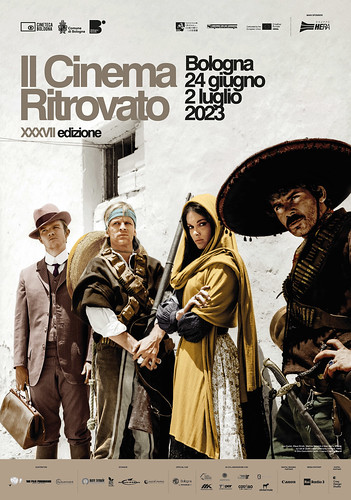 The official poster of Il Cinema Ritrovato 2023. Photo: Divo Cavicchioli / Surf Film. Lou Castel, Klaus Kinski, Martine Beswick and Gian Maria Volonté, with their eyes fixed on the horizon. A shot taken by Divo Cavicchioli on the 1966 set of Quién sabe?/El chuncho, quien sabe?/A Bullet for the General by Damiano Damiani.
The official poster of Il Cinema Ritrovato 2023. Photo: Divo Cavicchioli / Surf Film. Lou Castel, Klaus Kinski, Martine Beswick and Gian Maria Volonté, with their eyes fixed on the horizon. A shot taken by Divo Cavicchioli on the 1966 set of Quién sabe?/El chuncho, quien sabe?/A Bullet for the General by Damiano Damiani.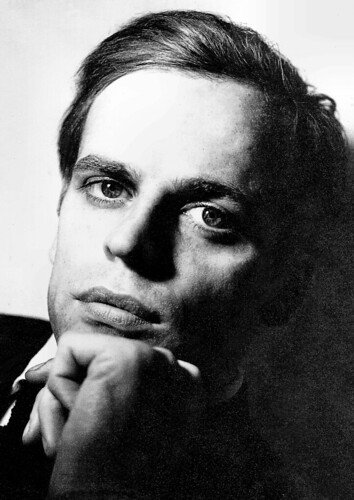
German postcard by Limited Editions, AZ/Drehbuch, Film, no. 124. Photo: I. Letto, ca. 1956.
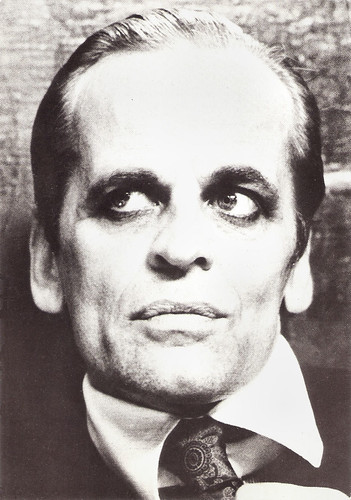
French postcard by Humour a la Carte, Paris, no. 82-11.
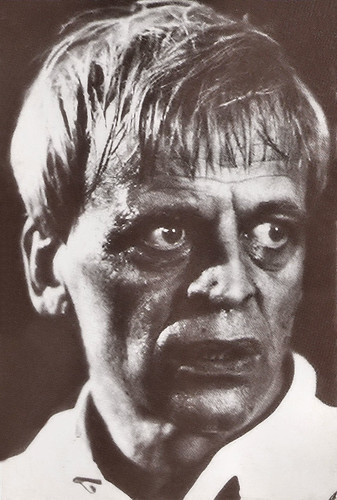
French postcard by Ébullitions, no. 26.

Portugese postcard for Concurso Fantasporto 83 by IV Edicao Internacional de Cinema Fantastico, Porto, 1984. Klaus Kinski in Fitzcarraldo (Werner Herzog, 1982).
Wild and unconventional behaviour
Klaus Kinski was born Nikolaus Günther Nakszyński in Zoppot, Danzig, Germany (now Sopot, Poland), in 1926. He was the son of a German father of Polish descent, Bruno Nakszyński, a pharmacist and a failed opera singer, and a German mother, Susanne Nakszyński-Lutze, a nurse and a daughter of a local pastor. He had three older siblings: Inge, Arne and Hans-Joachim. Because of the depression, the poor family was unable to make a living in Danzig and was forced to move to Berlin in 1931. They settled in a flat in the suburb of Schöneberg. From 1936 on, Kinski attended the Prinz-Heinrich-Gymnasium there.
During World War II, the 16-year-old enlisted in the Wehrmacht. Kinski saw no action until the winter of 1944 when his unit was transferred to the Netherlands. His obituary in Variety magazine states that there he was wounded and captured by the British on the second day of combat, but Kinski's autobiography Ich bin so wild nach deinem Erdbeermund (I Am So Wild About Your Strawberry Mouth, 1975) claims he made a conscious decision to desert.
However, Kinski was transferred to the Prisoner of War Camp 186 in Colchester, Great Britain. The ship transporting him to England was torpedoed by a German U-Boat but managed to arrive safely at its destination. At the POW camp, Kinski played his first theatre roles in shows staged by fellow prisoners intending to maintain morale. Following the end of the war in Europe in May 1945, Kinski was finally allowed in 1946 to return to Germany, after spending a year and four months in captivity.
Arriving in Berlin, Kinski learned his father had died during the war and his mother had been killed in an Allied air attack. Without having ever attended any professional training, he started out as an actor, first at a small touring company in Offenburg and already using his new name Klaus Kinski. He was hired by the renowned Schlosspark-Theater in Berlin but was fired by the manager in 1947 due to his unpredictable behaviour.
Other companies followed, but his already wild and unconventional behaviour regularly got him into trouble. His first film role was a small part in Morituri (Eugen York, 1948) a drama about refugees from a concentration camp. In 1950, he stayed in a psychiatric hospital for three days; medical records from the period listed a preliminary diagnosis of schizophrenia. He only could find bit roles in films, and in 1955 Kinski twice tried to commit suicide.
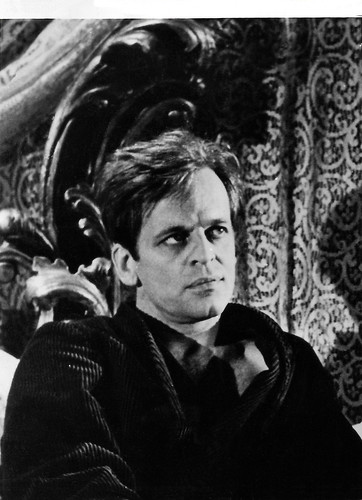
Vintage photo.
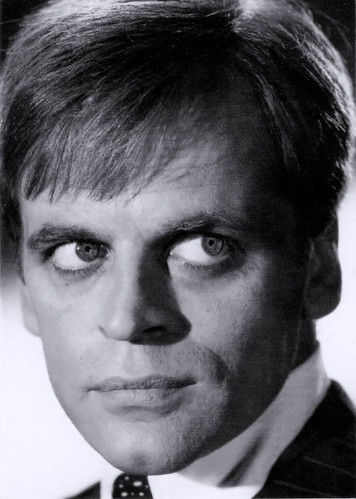
Danish postcard by Forlaget Holger Danske, no. 115. Photo: publicity still for Das Geheimnis der schwarzen Witwe/The Secret of the Black Widow (Franz Josef Gottlieb, 1963).
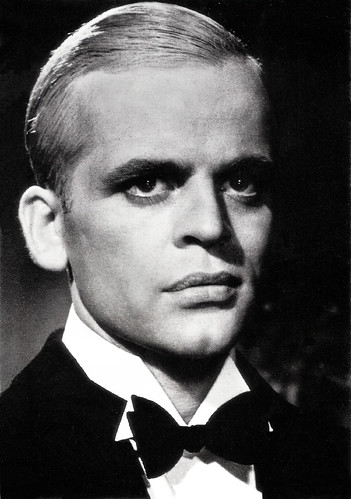
Danish postcard by Forlaget Holger Danske, no. 124. Photo: defd / Kinoarchiv Hamburg.

German postcard by Graphima, Berlin, no. 10. Photo: Klaus Kinski in Der letzte Ritt nach Santa Cruz/The Last Ride to Santa Cruz (Rolf Olsen, 1964).
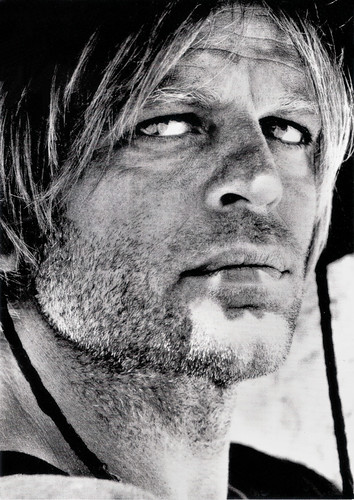
Danish postcard by Forlaget Holger Danske, no. 704. Photo: publicity still for E Dio disse a Caino.../And God Said to Cain (Antonio Margheriti, 1970).
Effective screen villain
Then Klaus Kinski got a supporting part in Ludwig II: Glanz und Ende eines Königs/Ludwig II (Helmut Käutner, 1955) about the frustrated and tragic King Ludwig II of Bavaria played by O.W. Fischer. More supporting parts in German films followed. In March 1956 Kinski made one single guest appearance at Vienna's Burgtheater in Goethe's Torquato Tasso.
Although respected by his colleagues, and cheered by the audience, Kinski's hope to get a permanent contract was not fulfilled, as the Burgtheater's management ultimately became aware of the actor's earlier difficulties in Germany. He unsuccessfully tried to sue the company. Living jobless in Vienna, and without any prospects for his future, Kinski reinvented himself as a monologist and spoken word artist. He presented the prose and verse of François Villon, William Shakespeare and Oscar Wilde among others. Thus he managed to establish himself as a well-known actor touring Austria, Germany, and Switzerland with his shows.
In 1960 he returned to the cinema as a sinister character on the verge between genius and madness in the thriller Der Rächer/The Avenger (Karl Anton, 1960) based on a crime novel by British writer Edgar Wallace. In another Wallace adaptation, Die toten Augen von London/The Dead Eyes of London (Alfred Vohrer, 1961), Kinski’s psychopathic bad guy refused any personal guilt for his evil deeds and claimed to have only followed the orders given to him. During the 1960s, Kinski appeared in several Wallace Krimis, which enjoyed enormous success in Germany and are now considered cult classics.
He also appeared in many other European genre films such as the Karl May Western Winnetou - 2. Teil/Last of the Renegades (Harald Reinl, 1964) featuring Pierre Brice. In these films, he built a reputation as an effective screen villain. In 1964, he relocated to Italy and was cast in the international production Doctor Zhivago (David Lean, 1965) as an Anarchist prisoner on his way to the Gulag. That year he also had a small part as a hunchback in the classic Italian western Per qualche dollaro in più/For Few Dollars More (Sergio Leone, 1965) starring Clint Eastwood.
Roles in numerous other Spaghetti westerns followed, including El chuncho, quien sabe?/A Bullet for the General (Damiano Damiani, 1966) with Gian Maria Volonté, Il grande silenzio/The Great Silence (Sergio Corbucci, 1968) starring Jean-Louis Trintignant, and Un genio, due compari, un pollo/A Genius, Two Partners and a Dupe (Damiano Damiani, 1975) with Terence Hill. When the Spaghetti Western genre was over its top, Kinski started to appear in other exploitation genres. Often these films proved to be brainless trash.

German postcard, no. R 21. Photo: publicity still for Winnetou - 2. Teil/Last of the Renegades (Harald Reinl, 1964).

German postcard, no. R 24. Photo: still from Winnetou - 2. Teil/Last of the Renegades (Harald Reinl, 1964) with Karin Dor as Ribanna and Pierre Brice as Winnetou.
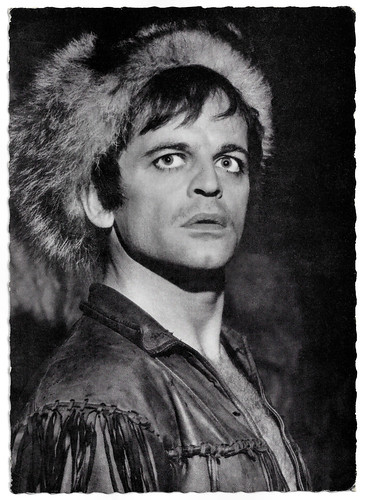
German postcard by Filmbilder-Vertrieb Ernst Freihoff, Essen, no. 891. Photo: Lothar Winkler. Klaus Kinski in Winnetou - 2. Teil/Last of the Renegades (Harald Reinl, 1964).

With Pierre Brice. German postcard by Filmbilder-Vertrieb Ernst Freihoff, Essen, no. 901. Photo: Lothar Winkler.

German postcard by Graphima, no. 1. Photo: publicity still for Winnetou - 2. Teil/Last of the Renegades (Harald Reinl, 1964).
An obsessive, terrifying, and emotionally unpredictable antihero
In 1972, in between his countless appearances in genre and exploitation films, Klaus Kinski suddenly found international recognition with the German production Aguirre, der Zorn Gottes/Aguirre: The Wrath of God (Werner Herzog, 1972).
At AllMovie, Karl Williams writes: “The most famed and well-regarded collaboration between New German Cinema director Werner Herzog and his frequent leading man, Klaus Kinski, this epic historical drama was legendary for the arduousness of its on-location filming and the convincing zealous obsession employed by Kinski in playing the title role. Exhausted and near to admitting failure in its quest for riches, the 1650-51 expedition of Spanish conquistador Gonzalo Pizarro (Alejandro Repulles) bogs down in the impenetrable jungles of Peru.
As a last-ditch effort to locate treasure, Pizarro orders a party to scout ahead for signs of El Dorado, the fabled seven cities of gold. In command are a trio of nobles, Pedro de Ursua (Ruy Guerra), Fernando de Guzman (Peter Berling), and Lope de Aguirre (Kinski). Travelling by river raft, the explorers are besieged by hostile natives, disease, starvation and treacherous waters. Crazed with greed and mad with power, Aguirre takes over the enterprise, slaughtering any that oppose him.”
Kinski delivered a bravura performance that typified his screen image: that of an obsessive, terrifying, and emotionally unpredictable antihero. Kinski and Herzog would make five films together, including Woyzeck (1978), Nosferatu: Phantom der Nacht/Nosferatu the Vampyre (1979) with Isabelle Adjani, and Fitzcarraldo (1982) with Claudia Cardinale.
The volatile love-hate relationship between Kinski and his equally driven and obsessive director Herzog resulted in some of the best work from both men, and both are best known for the films on which they collaborated. Kinski and Herzog pushed each other to extremes over a 15-year working relationship, which finally ended after filming Cobra Verde (Werner Herzog, 1987), a production plagued by volcanic clashes between the star and director, involving violent physical altercations and mutual death threats.
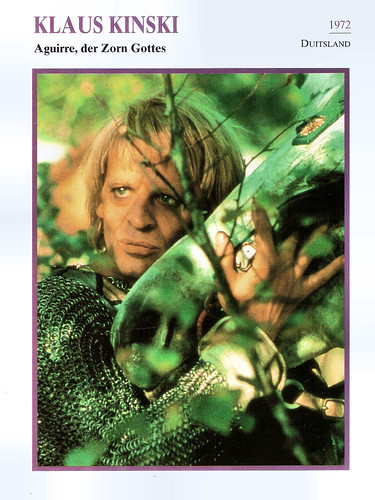
Dutch collectors card in the series 'Filmsterren: een portret' by Edito Service, 1995. Photo: Pele / Stills. Publicity still for Aguirre der Zorn Gottes/Aguirre, the Wrath of God (Werner Herzog, 1972).
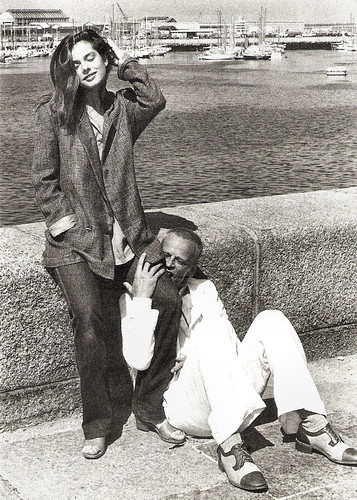
With his daughter Nastassja Kinski. French postcard in the Collection Cinéma by Editions Malibran, Paris, no. CF 50. Photo: Guidotti, 1978.

British postcard by Moviedrome, no. M45. Photo: 20th Century Fox. Publicity still for Nosferatu: Phantom der Nacht/Nosferatu the Vampyre (Werner Herzog, 1979) with Isabelle Adjani.
'Cretins' or 'scum'
The Encyclopaedia Britannica writes that Klaus Kinski “disdained his chosen profession, once saying, ‘I wish I’d never been an actor. I’d rather have been a streetwalker, selling my body, than selling my tears and my laughter, my grief and my joy’. Numerous offers from prestigious directors—whom Kinski categorised as ‘cretins’ or ‘scum’—were refused; he worked only when the money suited him.”
Kinski was also notorious – and in high demand – for his scandalous TV appearances and interviews. The scandals paid off. Although he continued to appear for the money in countless trash films, Kinski also starred in such respectable films as the French melodrama L'important c'est d'aimer/The Main Thing Is to Love (Andrzej Zulawski, 1975) starring a memorable Romy Schneider, and the Oscar-nominated Israeli production Mivtsa Yonatan/Operation Thunderbolt (Menahem Golan, 1977), based on the 1976 hijacking of a Tel Aviv-Athens-Paris Air France flight and the daring rescue of its 104 passengers in Entebbe, Uganda.
In the 1980s Kinski appeared prominently in such Hollywood productions as the comedy Buddy Buddy (Billy Wilder, 1981) as a neurotic sex scientist opposite Jack Lemmon and Walter Matthau, and the thriller The Little Drummer Girl (George Roy Hill, 1984) featuring Diane Keaton. Kinski’s last film was Kinski Paganini (Klaus Kinski, 1989), in which he played the 19th-century ‘devil’ violinist Niccolò Paganini. He also wrote and directed the film and his wife Debora and his son Nikolai also starred in the film. The production was marked by chaos and clashes between Kinski and his producers, who accused him of turning their production into a pornographic film and sued him in court. The result was a commercial and critical flop.
Kinski reinforced his image as a wild-eyed, sex-crazed maniac in his autobiography 'Ich bin so wild nach deinem Erdbeermund' (1975). In 1988 he updated and rereleased it as 'Ich brauche Liebe' (All I Need Is Love) and in 1997 it was again rereleased as 'Kinski Uncut'. The book infuriated many, and prompted his daughter Nastassja Kinski to file a libel suit against him. Werner Herzog would later say in his retrospective film Mein liebster Feind - Klaus Kinski/Kinski, My Best Fiend (Werner Herzog, 1999) that much of the autobiography was fabricated to generate sales; the two even collaborated on the insults about the director.
Klaus Kinski died of a heart attack in Lagunitas, California, U.S. at age 65. His ashes were scattered into the Pacific Ocean. He was married four times: to Gislinde Kühbeck (1952-1955), Brigitte Ruth Tocki (1960-1971), Minhoi Geneviève Loanic (1971-1979), and to Debora Caprioglio (1987-1989). His three children Pola Kinski (1952), Nastassja Kinski (1961) and Nikolai Kinski (1976) are all actors. In 2006 Christian David published the first comprehensive biography based on newly discovered archived material, personal letters and interviews with Kinski's friends and colleagues.

Small German collectors card.
Trailer for Il grande silenzio/The Great Silence (Sergio Corbucci, 1968). Dource: Danios12345 (YouTube).
Trailer for Nosferatu: Phantom der Nacht/Nosferatu the Vampyre (Werner Herzog, 1979). Source: Danios12345 (YouTube).
Long scene from Mein liebster Feind - Klaus Kinski/Kinski, My Best Fiend (Werner Herzog, 1999) with a raging Kinski during the shooting of Fitzcarraldo (1982). Source: Baranowski (YouTube).
Sources: Dan Schneider (Alt Film Guide), Michael Brooke (IMDb), Hal Erickson (AllMovie), Karl Williams (AllMovie), Encyclopaedia Britannica, Filmportal.de, Wikipedia and IMDb.
No comments:
Post a Comment